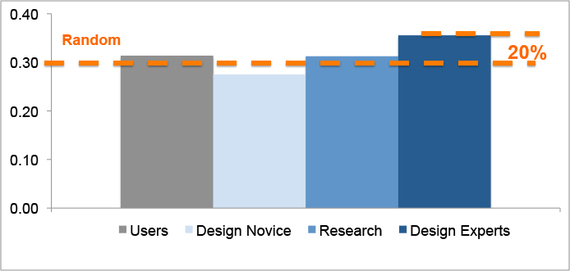Do some just have a gift for judging design and are design experts superior at judging a product's performance as compared with lay people?
Inviting students in business, design and engineering to rate product performance from images only, using products that had received the Industrial Design Excellence Award (IDEA) Gold, Silver, Bronze and also some that had not won, revealed that neither laypeople nor inexperienced designers possessed such abilities. On average, novice design students actually performed slightly worse than random samplings.
Not only was there no agreement between students within the same major, there was also non-agreement between majors. None of the student's ratings agreed with that of the design jury who had initially nominated the IDEA.
Even more mindboggling was that when inviting design researchers and design experts to assess product performance from images only, they fared no better than the students. However, as a group, on average, design experts outperformed design researchers, which again outperformed the students, when it came to being in agreement with the original IDEA jury.
Of course when design juries judge product performance, they do more than just look at pretty pictures, which might explain some of the medium correlation between the IDEA design jury and design expert assessments. When juries judge designs from a visual aesthetic (also called expression or styling) it represents only one of nine Design Quality Criteria that they either consciously or unconsciously use. Other criteria include: Design philosophy, Structure, Innovation, Social/human, Environmental, Viability, Process and Function.
So, how important is the aesthetic criteria when judging product performance as compared to the other eight criteria listed?
Recent studies at Hanyang University have revealed that aesthetics are the dominant factor when judging products and their business potential. In other words, we are unconsciously blinded by the "bling."
Or so it might appear. However, the lack of both individual students' and professionals' abilities to judge design performance from a visual suggests that what we are judging may not be the visual of the artifact at all. What we are actually evaluating may be the implicit story behind the "look."
Products are assessed in the context of the surrounding culture, as well as, other products and objects and the stories that have been constructed and evolved to describe these artifacts and support their right to exist.
As an example, in the late 1800's, pale women were the benchmark for beauty and their pale skin signaled that they did not have to work, something that was considered desirable at the time. In the 1950's, full figured women were adored and Marilyn Monroe, the sex symbol of that era, was quite voluptuous. Today, anorexic, suntanned women are considered to be most attractive, so the back-story has again changed dramatically.
Studies of designers' stories behind their concepts at Stanford University showed that aspects such as the activity for which the product was used and the actual functionality of the product acted as lead indicators of IDEA reception and the subsequent financial performance of the product.
The product's function and how it was used was consciously or unconsciously reflected in the designs' visual element and was then communicated to users of the product more cohesively than the indented aesthetic expression itself.
So, rather than relying on a single individual's design expertise for evaluating "glamour shots," applying the wisdom of a crowd of "design experts" to establish how a product expresses its function and use may offer best results in the marketplace.
